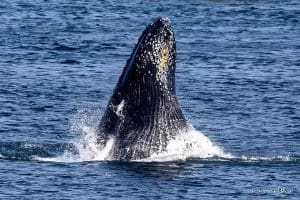Hey there, curious minds! Have you ever wondered how sea animals like whales and dolphins take a nap in the water without floating away? It’s like a super cool underwater secret! Imagine having a slumber party at the bottom of the sea – wouldn’t that be amazing? Well, get ready to dive into this exciting mystery with me! We’re about to uncover the awesome way these ocean animals sleep beneath the waves. It’s all about how they learned this special trick through a looong time, sort of like a superhero training! So, put on your imaginary scuba gear, and let’s unravel how these underwater champs turned snoozing into an art form!
Contents
- The Vital Need to Sleep: A Universal Necessity Across All Living Beings🐟
- Special Adaptations of Marine Mammals for Slumber Under the Waves.🐟
- Challenges and Risks of Slumber Beneath the Waves: A Delicate Balancing Act🐟
- Unveiling the Wonders of Underwater Sleep: Science and Tech Take the Dive.🐟
- The Amazing Ways Marine Animals Adapt to Sleep Underwater: A Tale of Ocean Marvels.🐟
The Vital Need to Sleep: A Universal Necessity Across All Living Beings🐟
Hey there, fellow explorers of the deep and dreamy! Today, we’re diving headfirst into a topic that links us all, from tiny critters to giant ocean roamers. Do whales sleep? Well, let me tell you, it’s a question that tugs at the strings of curiosity, much like a playful dolphin nudging its friend.
Imagine this: you’re curled up in your cozy bed, surrounded by the soft embrace of your favorite blanket. Sleep sweeps you into a world of dreams, where your body and mind recharge, preparing you for another day of adventures. But here’s the deal, it’s not just us land-dwellers who need this magical thing called sleep. It’s a fundamental need for all living beings on this planet, including those mysterious creatures that call the ocean home.
Why is sleep so darn important, you ask?
Well, think of it as nature’s way of pressing the reset button. When we close our eyes and drift into slumber, our bodies get busy with all sorts of behind-the-scenes tasks. It’s like a nighttime crew working to fix things up and make sure everything is running smoothly. Our brains sort through the jumble of information we gathered during the day, filing away the important stuff and tidying up.
Now, let’s talk about our watery pals, the whales. You know, the gentle giants of the sea who have mastered the art of gliding through waves. How do whales sleep in their underwater world? It’s a bit different from how we land-dwellers doze off. You see, whales have this superpower called unihemispheric slow-wave sleep. Fancy name, huh? What it means is that they can sleep with one half of their brain while the other half remains on standby mode. It’s like they’re playing a round of “nap tag” with their brains, making sure they’re always alert enough to swim and breathe.
Now, let’s put on our detective hats and figure out the difference between their slumber and ours. Unlike us, whales don’t have a snuggly bed to curl up in. They’re like floating sleepers, always ready for action even when they’re catching some Z’s. This incredible adaptation is part of their survival story – imagine if they snoozed too deeply and forgot to come up for air!
Special Adaptations of Marine Mammals for Slumber Under the Waves.🐟
Ahoy, curious souls and ocean adventurers! Ever wondered how those slippery sea creatures catch their Z’s beneath the surface? Buckle up, because we’re about to dive into the fascinating world of snoozing sea animals, where things get as interesting as a seashell treasure hunt. Do sea animals sleep? That’s a question that floats around our curious minds like a message in a bottle waiting to be discovered.
Unihemispheric Sleep: A Watery Slumber Party.
Let’s talk about the underwater marvels known as marine mammals. These are the real-life stars of the ocean, from the acrobatic dolphins to the gentle giants like whales. Now, you might think, “Hold up, how do these water-loving beings even get their shut-eye?” Well, it’s a story of incredible adaptations that’s as enchanting as a siren’s song.
First off, meet the unihemispheric sleep, a phenomenon as unique as a mermaid’s tale. You know how we humans doze off with our whole brain? Well, marine mammals like dolphins have cracked the code to sleeping with just one half of their brain at a time. It’s like they’re having a sleepover, and one buddy stays awake while the other takes a rest. This nifty trick keeps them alert enough to stay safe, even in the mysterious deep blue.
Dive into Sleep Styles: Shallow Naps and Deep Dreams.
Now, let’s talk about their sleep styles – it’s a mix of shallow naps and deep slumber, just like the ebb and flow of the tides. When it’s time for a quick recharge, they slip into a light nap mode, keeping an eye (or an eye patch, in this case) open to watch for any surprises. This ability to switch between snooze modes is like a superhero skill, allowing them to grab some rest without going too deep.
Float like a Dreamer: Mastering the Art of Buoyant Sleep.
You might be thinking, “Hey, how do they not sink while they sleep?” Well, marine mammals are like buoyant bedtime experts. They’ve got their body design dialed in to keep them afloat. It’s like having an invisible waterbed that keeps them from sinking while they snooze. Imagine having a bed that turns into a hammock on water – now that’s some serious sleep innovation!
Sleeping Positions: More Varied than Seashell Collections.
And here’s a fascinating twist – their sleeping positions are more varied than a collection of seashells on a beach. You’ve got dolphins that nap belly-side up, and whales that catch some Z’s vertically. It’s like they’re each mastering their own aquatic yoga pose for ultimate relaxation.
Challenges and Risks of Slumber Beneath the Waves: A Delicate Balancing Act🐟
Ahoy, fellow adventurers in the realm of the deep blue! Today, we’re delving into the mysterious world of underwater sleep, where the process of resting takes on a whole new dimension. Do dolphins sleep? It’s a question that dances on the tip of our tongues, much like the playful frolic of dolphins riding the waves.
Imagine you’re taking a peaceful nap by the seashore, the gentle sound of waves serenading you into slumber. Now, picture those magnificent marine mammals, like dolphins and whales, trying to catch some z’s in the ever-moving ocean. It’s a balancing act as delicate as a coral reef ecosystem.
The Dance of Vulnerability: Napping in a Predator’s Playground.
Let’s talk about the real-life hurdles these water dreamers face. You might think that sleep underwater is all smooth sailing, but in reality, it’s a challenge-filled journey. One of the biggest hurdles is the constant lurking danger from the deep – predators. Yes, even while they’re taking a break from the waves, marine animals can’t let their guard down completely.
Imagine a dolphin in its state of half-sleep, its unihemispheric process in motion. While one half of its brain rests, the other keeps a vigilant watch for potential threats. It’s like having a sentinel on duty even during the calm of a midday nap. The vulnerability is a reminder that in the vast ocean, where survival is an intricate dance, even sleep requires a level of vigilance.
The Breath of Life: A Balancing Act of Rest and Oxygen.
Now, let’s dive into the next challenge – the need to breathe. Just like you and me, marine animals need oxygen to survive, and that includes the moments when they’re catching their underwater Z’s. It’s a bit of a tricky situation, considering they’re in an environment that doesn’t exactly have a bedtime “off” switch.
Imagine this: dolphins need to surface to breathe, and even during sleep, they must make those vital trips for oxygen. It’s like your alarm clock ringing every few minutes during your nap to remind you to take a deep breath. This unique challenge shapes their sleep patterns, making their slumber a blend of rest and the necessary choreography of surfacing for air.
Resting Spots: Finding a Safe Harbor in the Deep.
And what about a place to rest? That’s another puzzle these ocean wanderers need to solve. Unlike us, they can’t simply lie down on a comfy bed. The need for surfaces of rest becomes an essential aspect of their underwater siesta. From the surface of the water to cozy nooks within coral reefs, finding a safe haven for sleep becomes a strategic mission.
Unveiling the Wonders of Underwater Sleep: Science and Tech Take the Dive.🐟
Hey there, fellow seekers of oceanic wisdom! Today, we’re diving into a tale that’s as fascinating as finding a shiny seashell on the beach. We’ve got some fishy business to explore: do sea animals sleep? And hey, how long can a whale hold its breath while sleeping? Imagine these questions as little puzzles waiting to be solved, just like figuring out where to put your beach umbrella on a sunny day.
So, picture this: scientists, like marine detectives, are on a mission to uncover the secrets of underwater slumber. They’re kind of like underwater reporters, but instead of microphones, they use special tools to spy on our aquatic buddies.
Getting Cozy with Behavior Studies: Snoozing Dolphins and Whale Watchers.
Ever wonder what dolphins and whales do when they’re ready to hit the hay? Well, scientists wonder too, and they’re not afraid to get their feet wet to find out. They grab their notebooks, hop on boats, and head out to the deep blue. It’s like a sleepover party with sea creatures, except they’re there to take notes. They watch how these animals swim, flip, and snooze, kind of like your mom watching to see if you’ve fallen asleep in your room.
This detective work helps scientists understand their sleep patterns – like, do dolphins take naps in short bursts, or do they snooze for longer like sleepyheads? It’s like piecing together a puzzle where every flip of a fin tells a story.
High-Tech Spying: Cameras and Gadgets for Ocean Slumber.
Now, let’s talk about the cool gadgets scientists use to spy on our underwater pals. Think of it as oceanic spying gear – cameras and microphones that let them peek into the secret world of sea sleep. They capture these creatures doing their snooze dance without interrupting their underwater shuteye.
Imagine a whale floating gracefully in the water, and scientists watching closely, not with binoculars, but with cool technology. They use these tools to figure out how whales manage to hold their breath while sleeping. It’s like solving a mystery where the clues are hidden beneath the waves.
The Amazing Ways Marine Animals Adapt to Sleep Underwater: A Tale of Ocean Marvels.🐟
Ahoy, fellow sea explorers! Our underwater adventure has been like a treasure hunt for knowledge, and today we’re reaching the final chapter. We’ve dived into questions like how long do whales sleep and do sea animals sleep, and now it’s time to wrap up this oceanic journey with a splash of wisdom.
Picture this: the ocean, like a giant playground, has secrets hidden beneath the waves. We’ve unveiled a few of those secrets, especially the ones about how our marine friends snooze underwater. It’s like finding a secret message in a bottle – a message of wonder and adaptation.
Nature’s Sleep Magic: The Stories of Dolphins and Whales.
We’ve learned about the incredible tricks that dolphins and whales use to get their beauty rest in the ocean. They’re like sleep superheroes with powers that let them nap without floating away or forgetting to come up for air. Imagine you’re dozing off on a floating cloud – that’s how they sleep in the watery world.
Lessons from the Sea: Adapt and Thrive.
As we wrap up this journey, here’s a lesson as clear as a sunny day by the shore: life in the ocean is all about adaptation. These sea sleepers face challenges like staying safe from predators and finding a comfy spot for their underwater siestas. And guess what? They’ve got the perfect strategies to tackle these challenges. It’s like learning to ride a wave and getting better at it every time.
Carry the Ocean’s Magic with You.
So, as you walk away from this watery adventure, remember to keep the ocean’s magic alive in your heart. When you see the waves kissing the shore, think about the incredible adaptations that let sea animals thrive. Just like fish in a school, they’ve learned to work together with nature’s rules to live their best ocean lives.


